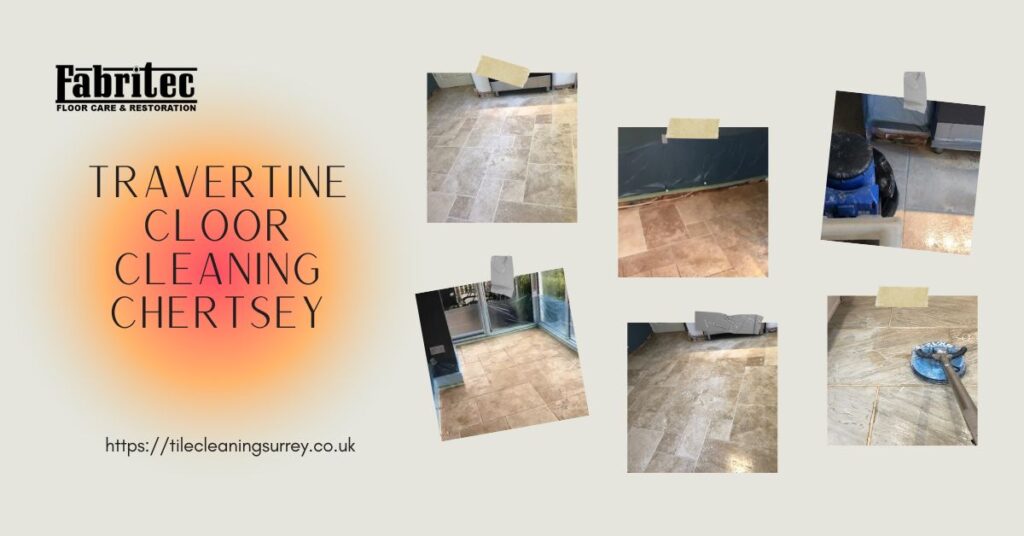
Background
Travertine floors are known for their natural beauty and unique appearance, but they require proper care and maintenance to maintain their charm over time. Recently, we had the opportunity to revitalise a well-worn travertine floor in a residential property in Chertsey, Surrey. This case study will illustrate the steps we followed to clean, repair, and seal the travertine floor, ensuring it not only looked new but also would last for years to come.
Initial Assessment and Preparation
Upon initial inspection, the travertine floor showed signs of wear, including visible dirt buildup in the grout lines, small natural holes typical of travertine stone, and some minor cracks in a few tiles. To ensure a clear workspace, we removed all furniture from the area before vacuuming up any loose debris and dust.
To protect surrounding surfaces, such as kitchen units and adjacent floors, we applied protective sheeting. This is critical in preventing any potential damage from cleaning agents or equipment during the cleaning process.
Deep Cleaning the Travertine Tiles and Grout
The key to revitalising travertine is a thorough, deep cleaning process. We started by applying a diluted, professional-grade travertine cleaner across the floor, paying special attention to grout lines and any heavily soiled areas. After allowing the cleaner to sit for about ten minutes to loosen embedded dirt, we used a rotary scrubbing machine to work the cleaner into the tiles.
This method effectively lifted the grime that had accumulated over time, leaving the surface visibly cleaner. To ensure the floor was completely clean, we followed up with pressure rinsing, a crucial step for removing any remaining cleaning slurry and debris. The rinse also eliminated any residues from previous sealers, preparing the surface for repair and sealing.
Repairing the Travertine Tiles
Upon cleaning, we discovered a few natural holes and minor cracks in the travertine tiles, common in this type of stone. To address these issues:
Filling Holes:
We filled the natural holes using high-quality beige fillers that blended well with the existing tile colour. This step not only restored the uniformity of the floor but also prevented future dirt buildup in these crevices.
Repairing Cracks
For the cracked tiles, we used a resin grout that allows for slight movement without causing additional cracks. Colour-matching the grout to the tile ensured that the repairs were almost invisible, maintaining the floor’s seamless aesthetic.
Sealing the Travertine Floor
The final, yet most critical, step in this process was sealing the travertine floor. Sealing protects the stone from stains, spills, and everyday wear and tear, thus extending the floor's life. For this project, we applied a high-solids, breathable sealer that not only penetrated the travertine but also formed a protective barrier on the surface.
Our client preferred a satin finish, which enhanced the natural beauty of the travertine without making it overly glossy. After the sealer was applied, we allowed it to cure for several hours, ensuring the floor was ready for regular use.
Aftercare Recommendations
To maintain the travertine's refreshed appearance, we advised the client to follow a regular cleaning routine:
- Use a pH-neutral cleaner specifically designed for sealed natural stone, such as LTP Floorshine, to avoid damaging the sealer.
- Regularly vacuum or dust the floor to prevent dirt from scratching the surface.
- Immediately clean up any spills to prevent staining.
- Reapply the sealer every 2 to 3 years, depending on foot traffic, to maintain the floor's protection and appearance.
Outcome
After completing the cleaning, repairing, and sealing processes, the travertine floor in the Chertsey property was transformed. The floor now had a renewed lustre, the grout lines were clean, and the repaired cracks were barely noticeable. The client was delighted with the results, and the floor was protected against future damage, ensuring it would remain beautiful for years to come.
We couldn’t be happier with the results! Our travertine floor looks absolutely stunning—like it’s brand new again. The team was professional, thorough, and took great care to restore every detail. We’re thrilled with how well the repairs blend in, and the sealing has made cleaning so much easier. Highly recommend their service!
This project highlights the importance of regular professional maintenance for travertine flooring to preserve both its aesthetic appeal and functional longevity.
Frequently Asked Questions
How Often Should I Clean My Travertine Tiles?
Cleaning travertine tiles should occur regularly, ideally once or twice a week, depending on foot traffic. Additionally, deep cleaning every six months guarantees the maintenance of their aesthetic appeal and longevity. Always use appropriate cleaners.
Can I Use Vinegar to Clean Travertine Surfaces?
Using vinegar to clean travertine surfaces is not advisable, as its acidity can damage the stone and its protective seal. Instead, opt for a pH-balanced cleaner specifically formulated for natural stone to maintain its integrity.
What Are Common Signs of Travertine Damage?
Common signs of travertine damage include visible cracks, chips, discoloration, and uneven surfaces. Additionally, persistent stains or dullness indicate wear, necessitating immediate attention to maintain both the aesthetics and structural integrity of the flooring.
Is Travertine Suitable for Outdoor Use?
Travertine is suitable for outdoor use due to its durability and natural slip resistance. However, proper sealing is essential to protect it from weathering and staining, ensuring longevity and maintaining its aesthetic appeal in outdoor environments.
How Can I Prevent Future Staining on Travertine?
To prevent future staining on travertine, apply a high-quality sealer regularly, promptly clean spills, and utilise pH-neutral cleaners. Additionally, maintain a consistent cleaning routine to enhance the stone's durability and aesthetic appeal.
The post: Travertine Cleaning Chertsey was produced by Travertine Floor Cleaning Chertsey
The Article Cleaning and Sealing a Travertine Floor in Chertsey, Surrey appeared first on https://fabritec.org
The Article Cleaning and Sealing a Travertine Floor in Chertsey, Surrey Was Found On https://limitsofstrategy.com
The Article Cleaning and Sealing a Travertine Floor in Chertsey, Surrey First Appeared ON
: https://ad4sc.com


It’s interesting to see the detailed process you followed for revitalising the travertine floor. Travertine definitely has that elegant touch that can elevate a space, but as you’ve pointed out, proper maintenance is crucial. I’ve encountered similar challenges with natural stone floors in my own home, particularly with the grout lines. It’s fascinating how dirt can accumulate over time, almost as if the floors have a story to tell.
I’m glad you found the process interesting! Travertine really does have a way of transforming a space, doesn’t it? And you’re spot on about the grout lines—they can really tell a story about how much traffic an area has seen. It’s almost like a timeline of life in your home, right?
“I’m glad you found the process insightful! If you’re interested in further tips on maintaining natural stone floors and keeping those grout lines looking fresh, check out our comprehensive guide here.”
https://oldicom.net/octopus
It’s great to hear you found the process of revitalizing travertine interesting. The elegant touch that natural stones like travertine bring to a space is hard to overlook, but, as you mentioned, maintenance can feel like a constant battle. I can relate to your experience with grout lines; it’s like they become the unwelcome storytellers of our floors, collecting dirt and grime over time.
“I’m glad you found the process interesting! If you’re looking to tackle those grout line challenges and bring your natural stone floors back to life, check out this guide for tips and tricks that can make a big difference.”
https://oldicom.net/webilaro
It’s fascinating to see how travertine, with its rich history and natural beauty, can transform a space yet require such dedicated care. Your detailed approach to revitalizing the floor highlights not just the technical aspects of restoration, but also the aesthetic and emotional value these surfaces can bring to a home.
I really appreciate your thoughts on travertine. It’s true that this stone carries so much history with it, almost like a piece of art that evolves over time. What I find really interesting is how each slab can tell a different story, shaped by the environment it’s been in and the care it’s received.
“To explore more about the beauty and care of travertine, check out our exclusive guide on revitalizing these stunning surfaces!”
https://oldicom.net/quillbot
It’s always fascinating to see how natural materials like travertine can transform a space. I’ve noticed that many homeowners often overlook the upkeep needed for such beautiful stones, thinking that their durability means little maintenance. Your case study really highlights the detailed preparation and care involved—especially with the protective measures to safeguard surrounding areas.
It’s true that natural materials can bring such a unique character to a space, and travertine is a prime example of that. The texture and warmth it provides can really change the atmosphere of a room. I’ve had a few experiences myself with different types of stone in home renovations, and I found that the upkeep requires a mindset shift.
I found an insightful piece that delves into the proper upkeep of travertine floors, shedding light on the meticulous cleaning and sealing process that really brings out their beauty while ensuring lasting durability.
‘Travertine Floor Cleaning and Sealing in Chertsey’
https://oldicom.net/travertine-floor-cleaning-and-sealing-in-chertsey/.
It’s great to hear about your experiences with stone in renovations. Travertine really does have a way of transforming a space, doesn’t it? That unique texture brings warmth that man-made materials often can’t replicate. But you’re right about the upkeep. It’s a shift in mindset for sure.
“Thanks for sharing your thoughts! If you’re looking for detailed guidance on caring for travertine, you might find this resource on cleaning and sealing to be quite helpful.”
https://oldicom.net/quillbot
It really is striking how much natural materials like travertine can contribute to the overall feel of a space, isn’t it? The elegance they bring is undeniable. However, I completely agree with your point about maintenance. Many people might assume that because stone is sturdy, it doesn’t require much care. But in reality, each type of stone has its own quirks, and understanding those can really make or break the longevity of the investment.
I totally agree with you about the elegance of natural materials like travertine. There’s something so grounding about using stone in our spaces; it connects us to nature in a way that artificial materials just can’t replicate. And you’re right—many folks overlook the maintenance aspect. I think it’s fascinating how each type of stone really does have its own personality. For instance, I’ve found that while travertine looks stunning, it can be a magnet for stains if it’s not properly sealed.
You’re so right about the upkeep of natural materials like travertine. It’s easy to get swept up in the beauty of these stones and forget that they require regular maintenance to truly shine. I’ve seen homeowners disheartened when they realize that the durability doesn’t mean “no maintenance” — it just means they need to approach care a bit differently.
You bring up such a solid point about natural materials like travertine. It’s easy to be swept away by their beauty and think they’ll take care of themselves just because they look tough. But, as you noted, there’s definitely a lot that goes into maintaining them.
The restoration of travertine floors is such a fascinating topic, especially considering the balance required between preserving the stone’s natural beauty and ensuring its longevity. I’ve always appreciated how stone floors can tell a story through their unique imperfections and variations. It’s clear that the initial condition of the floor you encountered in Chertsey reflected not only age but also the homeowners’ lifestyle, which probably subjected it to every bit of daily life, perhaps from children playing to pets roaming around.
You hit the nail on the head about travertine floors. They really are like a canvas that reflects a family’s history. When you look closely, every scratch and stain tells a story—from the little ones zooming around on their scooters to the pets finding their favorite sunny spots. It’s fascinating how much personality a floor can have, right?
Absolutely, the unique character of each stone really does tell a story! If you’re intrigued by the restoration process and want to explore more about maintaining those beautiful travertine floors, check out this helpful guide.
https://oldicom.net/quillbot
It’s fascinating to see the meticulous process involved in revitalizing travertine floors. They truly have a timeless appeal, yet I often wonder how the materials we choose for our homes impact not just aesthetics, but our environmental footprint as well. Travertine, being a natural stone, offers durability and a unique character, but it also requires mindful care to extend its life, as you’ve highlighted.
You’ve raised an important point about the intersection of materials and our environmental impact. Travertine’s stunning aesthetics and unique patterns certainly stand out, but it’s the behind-the-scenes considerations that often get overlooked. Choosing natural stone like travertine resonates with a desire for timeless beauty, but you’re right in highlighting the need for thoughtful care.
You raise an important point about the environmental aspects of our material choices in home design. Travertine, with its natural origins, does offer a certain sustainability compared to synthetic materials, but it’s worth diving deeper into how we can make the most of that.
It’s fascinating to see how much care and attention goes into revitalizing a travertine floor, especially considering how these natural stones tell their own story through wear and time. The steps you’ve detailed—from the initial assessment to the protective measures taken—highlight the importance of respecting the material’s unique characteristics.